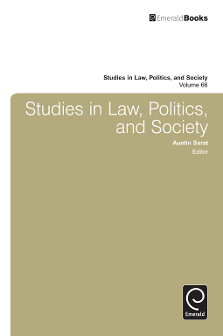Studies in Law, Politics, and Society: Volume 66

Table of contents
(12 chapters)Abstract
This chapter examines how opponents of same-sex marriage have used rights discourse to construct an identity of themselves as victims, and construct gays and lesbians as deviant “others.” I find that conservative rights discourse has been more effective outside the courtroom than in it. This is because these arguments rely on implicit discriminatory stereotypes which are frequently exposed under the scrutiny of dispassionate judicial actors. However, in a popular arena, they are free to operate with considerably less scrutiny. Here, rights discourse is used to mask discriminatory stereotypes and lend legitimacy to positions that would be rejected if made explicitly.
Abstract
The nexus where law, social movements, and organizations meet demands further explication. This research adds to our understandings of these dynamics by examining the case of the central Appalachian anti-strip mining movement. After developing a social network technique to analyze over thirty years of newspapers, we find a period of reduced movement activity following the passage of the Surface Mining Control and Reclamation Act of 1977. Conversely, we observe a reinvigoration of the movement following the passage of the Clean Air Amendments of 1990 and the perverse incentives they created for mountaintop removal mining. Finally, we see that joint participation in lawsuits is a primary tie that binds these groups together.
Abstract
There has been a tremendous decline in the use of the death penalty in the United States. Recent research using county-level data shows that a small minority of locales in the country account for death sentences and even fewer for executions. Drawing on theoretical work that seeks to account for why these locales continue to use capital punishment, we provide in this chapter a thick description of Maricopa County, Arizona, one of the most active death penalty locales in the contemporary United States. In doing so, we demonstrate how capital punishment operates in a field of violently defended racial boundaries. Our chapter shows the roles of various local actors across time in fortifying such racial boundaries through historical white terrorism and more recent reinforcement of zones of racial exclusion that are embodied especially in communicated fears of “illegal immigrant gangs.” We contend that the case of Maricopa County points to the importance of attending to racist localisms as a catalyst for the continued implementation of the death penalty in the United States.
Abstract
The International Criminal Court has institutionalized the concept of individual responsibility for human rights violations. The jurisprudence of international criminal law has developed along with the institution. Affirmative defenses in the mitigation of punishment or avoidance of responsibility are becoming increasingly important in international criminal procedure. We contend that diminished culpability based on advances in neuroscience provides the most challenging set of choices for the international legal community. Of the variety of affirmative defenses, emerging neuroscience-based defense provide the most challenging set of choices for the international legal community. The Esad Landzo case at the ICTY brings these challenges into focus. We discuss the difficult choices the International Criminal Court will have to make to balance the rights and needs of the victims and the due process rights of the accused.
Abstract
While the concept of legal culture has been receiving a growing attention from scholars, this research often overemphasizes the similarity of the opinions held by different segments of population. Furthermore, the relationship of migration and the change of legal-cultural attitudes has not received particular attention. Drawing on 70 in-depth interviews with the immigrants of the early 1990s from the former Soviet Union to Israel and the secular Israeli Jews, this chapter provides a comprehensive account of the various aspects of legal culture of these groups. The second important finding is the persistence of the legal-cultural attitudes and perceptions over time.
Abstract
This chapter examines the conundrum of juvenile immigration law and policy and argues that it is a present-day manifestation of “child-saving” in rhetoric, disposition, and human capital harm. In support of this thesis, the chapter reviews the pertinent human rights, law, and social science evidence, and it concludes that the maintenance of the nation’s existing immigration policy only makes sense within the context of the intentions of the 19th century child-saving movement. To substantiate this view, the political-economic drivers of contemporary US immigration policy (i.e., its child-saving dynamics) are explored. The chapter concludes by speculatively addressing the character (i.e., the form and quality) of modern-day juvenile immigration policy as child-saving informed by the philosophy and criticism of Psychological Jurisprudence (PJ).

- DOI
- 10.1108/S1059-4337201566
- Publication date
- 2015-01-03
- Book series
- Studies in Law, Politics, and Society
- Editor
- Series copyright holder
- Emerald Publishing Limited
- ISBN
- 978-1-78441-568-6
- eISBN
- 978-1-78441-567-9
- Book series ISSN
- 1059-4337